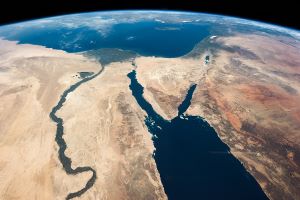9_edit.jpg

The “tropicalization” of the Mediterranean Sea involves its warming, but also the invasion of many species from the Red Sea. Credit: NASA.
The Suez Canal is an easy path for invaders. It’s brought hundreds of species of fish, crabs, and other non-native critters into the Mediterranean Sea. And they’re causing all kinds of problems.
The invaders traverse the 120-mile canal from the Indian Ocean and the Red Sea. And over time, they spread out. Many early invaders didn’t survive because the water was too cold. But the Mediterranean is warming much faster than the oceans as a whole. That makes it more comfortable for the newbies, and less comfortable for native species.
And there are a lot of invaders—almost a thousand species, according to a recent report. Some especially troublesome ones include lionfish and rabbitfish. The lionfish gulp huge amounts of food, which has drastically reduced the populations of native fish. The rabbitfish devour kelp and seagrass, depriving the natives of habitat. The effects are dramatic: some fisheries in Turkey have reported that 80 percent of their catch is rabbitfish.
Another invader is the blue crab. It entered the Mediterranean decades ago. It stuck around in the southern and eastern parts of the sea for a while, but in 2014 it was discovered off Tunisia, which is farther north and west. It’s aggressive and it reproduces quickly, so it overpowered native species. That decimated the local harvest—for a while. With new nets and techniques, fisher people have started hauling in blue crabs—almost 8,000 tons in 2021—making the best of a marine invasion.

